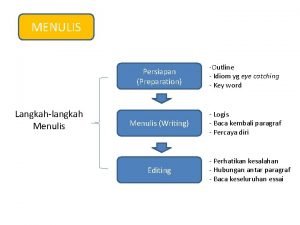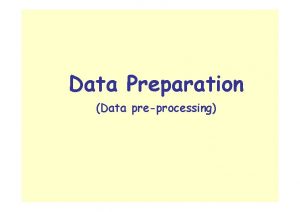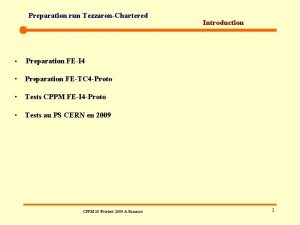Chapter XIV Data Preparation Chapter Outline 1 Overview













- Slides: 13

Chapter XIV Data Preparation

Chapter Outline 1) Overview 2) The Data Preparation Process 3) Questionnaire Checking 4) Editing i. Treatment of Unsatisfactory Responses 5) Coding i. Coding Questions ii. Code-book iii. Coding Questionnaires

6) Transcribing 7) Data Cleaning i. Consistency Checks ii. Treatment of Missing Responses 8) Statistically Adjusting the Data i. Weighting ii. Variable Respecification iii. Scale Transformation 9) Selecting a Data Analysis Strategy Adjusting the Data

10) A Classification of Statistical Techniques 11) Ethics in Marketing Research 12) Internet & Computer Applications 13) Focus on Burke 14) Summary 15) Key Terms and Concepts 16) Acronyms

Fig. 14. 1 Data Preparation Process Prepare Preliminary Plan of Data Analysis Check Questionnaire Edit Code Transcribe Clean Data Statistically Adjust the Data Select Data Analysis Strategy

Table 14. 1 Records Record 11 Record 21 Record 31 Record 2701 An Illustrative Computer File 1 -3 4 5 -6 001 002 003 004 271 1 1 31 31 31 Fields Column Numbers 7 -8. . . 26. . . 01 01 55 6544234553 5564435433 4655243324 5463244645 6652354435 35 77 5 4 4 6 5

Data Transcription Fig. 14. 4 Raw Data CATI/ CAPI Keypunching via CRT Terminal Mark Sense Forms Optical Scanning Computerized Sensory Analysis Verification: Correct Keypunching Errors Computer Memory Disks Transcribed Data Magnetic Tapes

Fig. 14. 5 Selecting a Data Analysis Strategy Earlier Steps (1, 2, & 3) of the Marketing Research Process Known Characteristics of the Data Properties of Statistical Techniques Background and Philosophy of the Researcher Data Analysis Strategy

Fig. 14. 6 A Classification of Univariate Techniques Non-numeric Data Metric Data One Sample * t test * Z test Two or More Samples Independent * Two. Groupt test * Z test * One-Way ANOVA Related * Paired * t test One Sample * Frequency *Chi-Square *K-S *Runs * Binomial Two or More Samples Independent * Chi-Square * Mann-Whitney * Median * K-S * K-W ANOVA Related * Sign * Wilcoxon * Mc. Nemar * Chi-Square

A Classification of Multivariate Techniques Fig. 14. 7 Multivariate Techniques Dependence Technique One Dependent Variable * Cross. Tabulation * Analysis of Variance and Covariance * Multiple Regression * Conjoint Analysis More Than One Dependent Variable * Multivariate Analysis of Variance and Covariance * Canonical Correlation * Multiple Discriminant Analysis Interdependence Technique Variable Interdependence * Factor Analysis Interobject Similarity * Cluster Analysis * Multidimensional Scaling

RIP 14. 1 Nielsen’s Internet Survey: “Does It Carry Any Weight? ” The Nielsen Media Research Company, a longtime player in television-related marketing research has come under fire from the various TV networks for its surveying techniques. Additionally, in another potentially large, new revenue business, Internet surveying, Nielsen is encountering serious questions concerning the validity of its survey results. Due to the tremendous impact of electronic commerce on the business world, advertisers need to know how many people are doing business on the Internet in order to decide if it would be lucrative to place their ads online. Nielsen performed a survey for Commerce. Net, a group of companies that includes Sun Microsystems and American Express, to help determine the number of total users on the Internet.

Nielsen’s research stated that 37 million people over the age of 16 have access to the Internet and 24 million have used the Net in the last three months. Where statisticians believe the numbers are flawed is in the weighting used to help match the sample to the population. Weighting must be used to prevent research from being skewed towards one demographic segment.

The Nielsen survey was weighted for gender but not for education which may have skewed the population towards educated adults. Nielsen then proceeded to weight the survey by age and income after they had already weighted it for gender. Statisticians also feel that this is incorrect because weighting must occur simultaneously, not in separate calculations. Nielsen does not believe the concerns about their sample are legitimate and feel that they have not erred in weighting the survey. However, due to the fact that most third parties have not endorsed Nielsen’s methods, the validity of their research remains to be established.
 Data quality and data cleaning an overview
Data quality and data cleaning an overview Data quality and data cleaning an overview
Data quality and data cleaning an overview Data quality and data cleaning an overview
Data quality and data cleaning an overview Data preparation and basic data analysis
Data preparation and basic data analysis Markku roiha
Markku roiha Chapter 21 section 2 the reign of louis xiv
Chapter 21 section 2 the reign of louis xiv Chapter 21 section 2 the reign of louis xiv
Chapter 21 section 2 the reign of louis xiv Subpoints in a preparation outline are
Subpoints in a preparation outline are Preparation outline
Preparation outline The visual framework of a preparation outline
The visual framework of a preparation outline Example of quote sandwich
Example of quote sandwich Master data services overview
Master data services overview Sql server enterprise master data management
Sql server enterprise master data management Chicago time
Chicago time
























